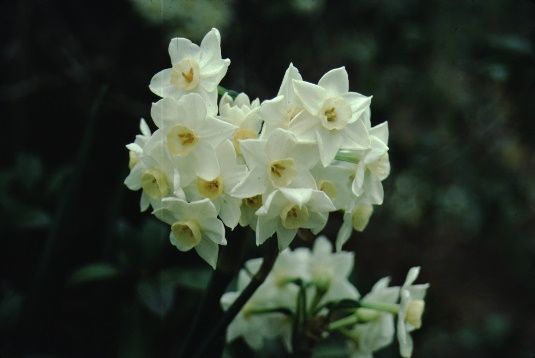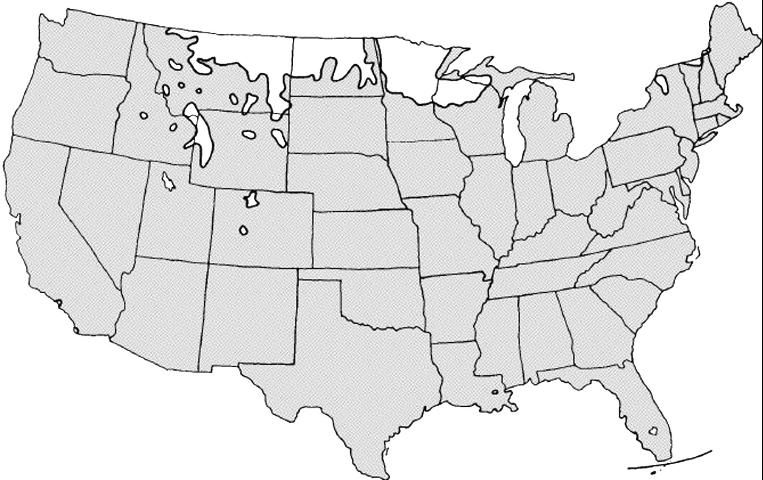Introduction
The well-known daffodil is now available in single or double flower forms in various color combinations of yellow, white, apricot, cream, peach, red, or orange. Long used in forced pot culture, daffodils make attractive naturalized ground covers in sweeping drifts or under trees. Daffodils also work well under shrubs, in rock gardens or near water, or used as an edging plant. Few plants seem to signify the freshness of spring quite as well as daffodils.

Credit: Edward F. Gilman, UF/IFAS

Credit: Edward F. Gilman, UF/IFAS
General Information
Scientific name: Narcissus spp.
Pronunciation: nar-SIS-suss species
Common name(s): daffodil, narcissus
Family: Amaryllidaceae
Plant type: perennial; herbaceous
USDA hardiness zones: 3B through 10 (Figure 3)
Planting month for zone 7: year-round
Planting month for zone 8: year-round
Planting month for zone 9: year-round
Planting month for zone 10: year-round
Origin: not native to North America
Invasive potential: not known to be invasive
Uses: mass planting; border; container or above-ground planter; edging; suitable for growing indoors
Availability: generally available in many areas within its hardiness range

Credit:
Description
Height: 1 to 2 feet
Spread: 0.5 to 2 feet
Plant habit: upright
Plant density: moderate
Growth rate: moderate
Texture: fine
Foliage
Leaf arrangement: most emerge from the soil, usually without a stem
Leaf type: simple
Leaf margin: entire
Leaf shape: linear
Leaf venation: parallel
Leaf type and persistence: deciduous
Leaf blade length: 12 to 18 inches
Leaf color: green
Fall color: no fall color change
Fall characteristic: not showy
Flower
Flower color: white; yellow, cream; apricot; red; orange
Flower characteristic: spring flowering; pleasant fragrance; winter flowering
Fruit
Fruit shape: unknown
Fruit length: unknown
Fruit cover: unknown
Fruit color: green
Fruit characteristic: inconspicuous and not showy
Trunk and Branches
Trunk/bark/branches: not applicable
Current year stem/twig color: not applicable
Current year stem/twig thickness: not applicable
Culture
Light requirement: plant grows in part shade/part sun
Soil tolerances: occasionally wet; acidic; sand; loam; clay
Drought tolerance: high
Soil salt tolerances: poor
Plant spacing: 6 to 12 inches
Other
Roots: not applicable
Winter interest: plant has winter interest due to unusual form, nice persistent fruits, showy winter trunk, or winter flowers
Outstanding plant: not particularly outstanding
Pest resistance: long-term health usually not affected by pests
Use and Management
Hundreds of cultivars exist today, and planting dates will vary accordingly, but the bulbs are usually planted in fall when the soil is cool. Although daffodils grow well in full sun or light shade, the flowers last longer in light shade. The bulbs are planted with four to five inches of soil on top of them. If spaced eight inches apart, the bulbs should not need to be divided for two to three years. Double-nosed bulbs are actually two blooming-sized bulbs joined together. When selecting a location for planting, it should be noted that the individual flowers will face the sun.
Bulbs should be watered well after planting and, in the south, thereafter if winters are dry. After flowering, plants should continue to be watered and fertilized. The foliage should be allowed to naturally turn yellow and die without being removed because it will help supply energy to the bulb for the next year's bloom. When flowering becomes sparse and the blooms small, division of the bulbs may be necessary. After the foliage has died down, dig and lift the bulbs, separating off only those bulbs which come off easily. Replant at once or store at 45°F for a very short period.
Pests and Diseases
The tulip bulb aphid damages stored bulbs and feeds on the leaves and other above ground parts in the spring.
The bulb mite causes infested bulbs to produce stunted leaves and deformed flowers.
Bulb flies will infest narcissus. The larvae make the bulbs soft and unable to grow. The openings created by the insect are entrances for diseases.
Millipedes will feed on the undersides of bulbs.
The stem and bulb nematode cause darkened bulb scales, giving a ringed appearance to bulb cross sections. Yellowish pockets in the bulb contain many nematodes. Infested bulbs do not grow or fail to flower. The shoots are abnormal and twisted. Remove infested plants and avoid rich wet soil with a high humus content.
Blue mold is a storage problem and is worse on injured bulbs. The disease is most likely to occur in moist storage conditions.
Crown rot covers bulbs with layers of course, white mold. Remove infected plants and avoid infested soil for two to three years.
Basal rot causes a decay starting at the roots or bases of the scales, and spreads upwards inside the bulb. The plants are dwarfed and the blossoms abnormal.
Fire causes spotting and rotting of flowers in humid weather. The disease spreads to, and rapidly destroys, the leaves. The symptoms on leaves are dark-reddish, elongated, brown spots. Rake up and destroy old foliage.
Leaf spot causes large spots or blotches on the leaves. The leaves wither and die. The bulbs lack nourishment due to the premature death of leaves. Remove and destroy plants with diseased foliage.
Smolder rots the foliage and flowers in cold, wet seasons. The leaves are stuck together when they emerge and infected bulbs rot in storage. Remove and destroy infected plants.
Root rot causes leaf yellowing and stunting and withering of plants. The roots have yellowish or brown discolored stripes and decayed regions. The bulbs remain sound. This disease is more of a problem where narcissi have been planted for several years.
Leaf scorch causes blighted leaf tips to be separated from healthy portions by a yellow area. The secondary infection on the lower leaves is minute, water soaked or yellowish spots, which become raised, scabby and reddish. The flower stalks and flowers may be spotted.